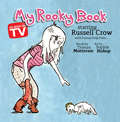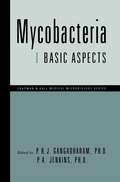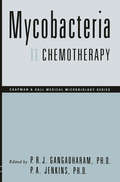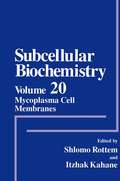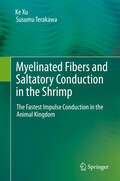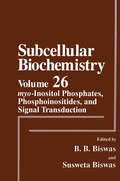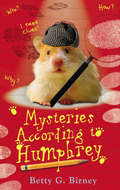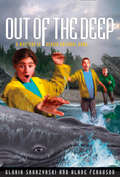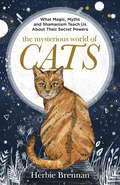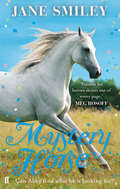- Table View
- List View
My Rescue Dog Rescued Me: Amazing True Stories of Adopted Canine Heroes
by Sharon Ward KeebleMeet the inspirational dogs who went from being rescued to becoming rescuer, in these incredible true stories. You’ll read all about the canine heroes who came to their owner’s aid – whether it was saving them from physical threats, or helping them to recover from mental illness, PTSD and bereavement.
My Rescue Pet Rescued Me: Amazing True Stories of Adopted Animal Heroes
by Sharon Ward KeebleMeet the inspirational animals who went from rescued to rescuer in these incredible true stories. You’ll read all about the animal heroes who came to their owner’s aid – whether it was helping them to recover from mental illness, relationship breakdown or bereavement. Let these stories warm your heart and reveal how animals can help us heal.
My Rooky Book (Starring Russell Crow)
by Tristan Motteram Sophie BishopRussell was originally thought to be a crow (and that’s how he was given his name!). But, even though Russell’s a rook, he liked the name so much - and Russell Crow stuck! He’s a mischievous bird. He poops on the floor. He steals food. He hides shiny things. But to Russell, she is his Miss Helen. To Helen, he is her Roo. They are family.
My Sand Life, My Pebble Life: A memoir of a childhood and the sea
by Ian McMillanMy Sand Life, My Pebble Life is a new book focusing on one of poet Ian McMillan's great loves – the sea – and the places and memories that have shaped who he is today.Comprised of a series of perfectly crafted, evocative, funny and nostalgic essays, Ian revisits the coastal places that stamped themselves on his childhood: Cleethorpes, where a bird once landed on the seat next to him as the miniature railway chugged along, California in Suffolk where his Auntie accidentally put her hand through the window of a caravan and bled spectacularly, Minehead in Somerset where his dad kept stalling the car and the family limped across the map and took all day to get a very short distance, Broadford on the Isle of Skye where midges descended on Ian like an apocalyptic umbrella.This book will transport you from your everyday life to a coast rich in memories of childhood and times spent by the sea.
My Sand Life, My Pebble Life: A memoir of a childhood and the sea
by Ian McMillanMy Sand Life, My Pebble Life is a new book focusing on one of poet Ian McMillan's great loves – the sea – and the places and memories that have shaped who he is today.Comprised of a series of perfectly crafted, evocative, funny and nostalgic essays, Ian revisits the coastal places that stamped themselves on his childhood: Cleethorpes, where a bird once landed on the seat next to him as the miniature railway chugged along, California in Suffolk where his Auntie accidentally put her hand through the window of a caravan and bled spectacularly, Minehead in Somerset where his dad kept stalling the car and the family limped across the map and took all day to get a very short distance, Broadford on the Isle of Skye where midges descended on Ian like an apocalyptic umbrella.This book will transport you from your everyday life to a coast rich in memories of childhood and times spent by the sea.
My Therapist's Dog: Lessons in Unconditional Love
by Diana WellsDiana Wells's intriguing exploration into the rewards of relationships--both the canine and human varieties--begins when she reluctantly starts seeing a psychologist, Beth, during a difficult time in her life. With no insurance to pay for counseling, a barter is arranged in which the client becomes part-time caretaker to the therapist's dog, Luggs, a sweet, clumsy black Labrador retriever. As Wells examines her past--her peripatetic childhood, her eccentric family, her grief over the deaths of loved ones--Luggs provides a bridge between therapist and patient. Dog lover by nature, historian by trade, Wells finds herself curious about the connections that dogs and humans have shared for centuries--and what these bonds tell us about our own psyches. Wells observes that training a dog has much in common with the therapeutic techniques her psychologist employs. Looking into recent experiments that have proved dogs better at interpreting human behavior than chimps or wolves, Wells explores the subtleties of her own relationship with dogs. Increasingly she finds herself agreeing with Diogenes, the original Greek cynic (the word cynic comes from the greek kuon, meaning "dog"), who said that unless we think like dogs, happiness will elude us. Wells analyzes what we name our dogs, how we breed them, how we've explored the wilderness with them, the kinds of literature we write about them, why we love them, and, most important, what we can learn from them. When an unexpected illness befalls Beth, Luggs comforts the two women, and his devotion helps Wells come to accept that relationships--despite the possibility of hurt and pain--are what life is all about.
My Wild Life: The Story of a Most Unlikely Animal Rescuer
by Simon CowellThe true, heart-warming story of how a reluctant City trader left a life of champagne and bonuses to follow his dream of rescuing animals and setting up a wildlife sanctuary.Simon Cowell always wanted to be a vet. Instead he ended up as a wealthy commodities trader. But with a love of nature and animals, he could never quite subscribe to the ‘greed is good’ mantra which rung out through the trading halls of the City of London.While his colleagues quaffed champagne and blew their bonuses on designer gear, Simon set up a wildlife sanctuary in the grounds of his stockbroker belt home. At 42, having suffered two nervous breakdowns, he finally left his job. That’s when his life began.Wild Life is the story of his remarkable journey from reluctant City swinger to environmental crusader, meeting some of the some of the cute and cuddly creatures that have touched his heart along the way.Often hilarious, sometimes harrowing and always insightful, Simon’s story is one man’s life-long mission to redress the damage man has done to the environment – with boozing, a divorce and some bad behaviour along the way.
Mycobacteria: I Basic Aspects
by Pattisapu R.J. Gangadharam P.A. JenkinsMycobacteria is divided into two volumes. The first volume deals with the basic biology of mycobacteria. With its emphasis on the state of the art outlook, this volume includes taxonomy and molecular biology of mycobacteria, modern approaches for detection of mycobacteria, and immunology and immunization against tuberculosis. The second volume covers drug trestments for mycobacteria anad tuberculosis. It outlines trends of discovery and development of chemotherapy, starting from the mid-50's to present day uses of chemotherapy in treating AIDS, drug-resistant tuberculosis, and other non-tuberculosis mycobacterial diseases.
Mycobacteria: II Chemotherapy (Chapman & Hall medical microbiology series)
by Pattisapu R.J. Gangadharam P.A. JenkinsMycobacteria is divided into two volumes. The first volume deals with the basic biology of mycobacteria. With its emphasis on the state of the art outlook, this volume includes taxonomy and molecular biology of mycobacteria, modern approaches for detection of mycobacteria, and immunology and immunization against tuberculosis. The second volume covers drug trestments for mycobacteria anad tuberculosis. It outlines trends of discovery and development of chemotherapy, starting from the mid-50's to present day uses of chemotherapy in treating AIDS, drug-resistant tuberculosis, and other non-tuberculosis mycobacterial diseases.
Mycobacterium tuberculosis: Interactions with the Immune System (Infectious Agents and Pathogenesis)
by Mauro Bendinelli Herman FriedmanTuberculosis once again occupies a special position in the areas of infec tious diseases and microbiology. This disease has been important to mankind since even before biblical times. Tuberculosis has been a major cause of morbidity and mortality in humans, especially in highly ur banized Europe, until a few decades ago. Indeed, this disease became a center of many novels, plays, and operas, since it appeared to be quite popular to have the heroine dying of "consumption. " Most importantly, tuberculosis also became the focus of attention for many investigations during the 19th and even the 20th centuries. Major advances were made in the areas of isolation and identification of M. tuberculosis and related microorganisms. The discovery, by Robert Koch, that tuberculosis was caused by an infectious agent revolutionized our thinking about dis eases. Koch's postulates were developed with tuberculosis in mind and became a focal point for many advances in microbiology and medicine. Studies with mycobacteria as a central focus have also led to revolu tionary new concepts about immunology in general. Koch himself showed that those exposed to M. tuberculosis develop a skin hypersen sitivity or allergy to the microorganism's antigens, an observation which was the starting point for many important developments. Indeed, imme diate-type hypersensitivity and atopic or IgE-mediated allergy were de fined in relation to the delayed-type cutaneous hypersensitivity evi denced with the tubercle bacillus.
Mycological Diagnosis of Animal Dermatophytoses (Transactions of the Prague Conferences on Information Theory)
by J. Dvorák M. OtcenásekThere are not many biological disciplines, which have experienced such fast development as have human and veterinary mycology in recent years. In the initial stages organisms, whoEe influence on man has not b~en determined, have been investigated on a purely academic basis and with particular reference to their taxonomic position. As recently as the thirties, the pathogenic agents of dermatophytoses were known collectively under such names as "Micro sporum" and "Trichophyton". Such designation occurred in most medical and veterinary literature irrespective of the fact that fungi are organisms of a highly complicated and most variable morphological structure, an intricate development and a distribution over a diversity of environments, infecting hosts of the animal kingdom. The greater the credit, therefore, that can be attributed to the pioneers of mycological research, the founders of modern mycology such as R. Sabouraud, M. Langeron, R. Vanbreuseghem, Ch. W. Emmons, who elucidated the importance of mycology in human and veterinary medicine. To one of them, Professor R. V anbreuseghem, this book has been dedicated. In spite of these tremendous efforts, many aspects of the biology and ecology of fungi have still remained obscure in view of the complicated develop ment throughout the various phases, the variability of species and the large numbers of purely saprophytic species occurring in nature. At the present, mycoparasitic infection in man and animals is of utmost importance.
Mycoplasma Cell Membranes (Subcellular Biochemistry #20)
The mycoplasmas, a trivial name used to denote organisms included in the class Mollicutes, are a group of prokaryotic organisms comprising more than 120 species distinguished from ordinary bacteria by their small size and the total lack of cell walls. The absence of a cell wall in mycoplasmas is a characteristic of outstanding importance to which the mycoplasmas owe many of their pecu liarities, for example, their morphological instability, osmotic sensitivity, unique ion pumping systems, resistance to antibiotics that interfere with cell wall bio synthesis, and susceptibility to lysis by detergents and alcohols. The fact that the mycoplasma cells contain only one membrane type, the plasma membrane, constitutes one of their most useful properties for membrane studies; once the membrane is isolated, it is uncontaminated with other mem brane types. Another advantage in using mycoplasmas as models for membrane studies stems from the fact that their membrane lipid composition can be altered in a controlled manner. This characteristic results from the partial or total inabili ty of the mycoplasmas to synthesize long-chain fatty acids and cholesterol, making mycoplasmas dependent on the supply of fatty acids from the growth medium. The ability to introduce controlled alterations in the fatty acid composi tion and cholesterol content of mycoplasma membranes has been utilized in studying the molecular organization and physical properties of biological mem branes.
Mycoplasmas in Swine
by Dominiek Maes, Marina Sibila & Maria PietersSwine can be infected with many different mycoplasmas. Some are important pathogens, causing significant health and welfare issues in pigs and major losses to the swine industry worldwide. Other mycoplasmas are not pathogenic for swine and can be considered commensals. This book provides up-to-date scientific, clinical and practical information of the most important pathogenic mycoplasmas in swine. Most emphasis has been placed on Mycoplasma hyopneumoniae as the most economically important, but other pathogenic species like Mycoplasma hyorhinis, Mycoplasma hyosynoviae and Mycoplasma suis are also discussed. Written by internationally renowned scientists and clinicians from all over the world, this book draws together in depth knowledge, expertise and experience in swine mycoplasmas to provide an evidence-based, academically rigorous and practical collection. It aims to serve the scientific and veterinary community and the swine industry worldwide.
Mycoses in AIDS Patients
by Geert Cauwenbergh Édouard Drouhet Donald W. R. Mackenzie Jan Van Cutsem Hugo Vanden BosscheThe World Health Organization estimates that at least five million people worldwide are infected with human immunodeficiency virus (HIV) Of these about 100,000 are in Asia and Oceania, 500,000 in Europe, 2 million in the Americas and 2.5 million in Africa (Mann, 1989). The acquired immunodeficiency syndrome is characterized by a derangement in cell-mediated immunity leading to opportunistic infections with for example Mycobacterium spp., Candida spp., Cryptococcus neoformans, Pneumocystis carinii, Toxoplasma gondii and Cryptosporidium. The third symposium on "Topics in Mycology" brought together 265 experts from 32 countries to discuss the epidemiology, immmunological and pathogenetic aspects of AIDS and its opportunistic infections in general and fungal infections in particular. Pneumocystis carinii pneumonia is by far the commonest opportunistic infection in AIDS patients. The nature and classification of P. carinii is still controversial. In search for its true taxonomic affinities an introductory paper formulates a number of key questions. Candidosis is another frequent opportunistic infection. A number of papers discuss the possibility that selective pressures may operate on Candida albicans within the AIDS population and influence its nature: this might have an impact on prophylaxis and curative and/or suppressive therapy.
Mycotoxins in Swine Production
by Ines Rodrigues Maximilian SchuhMycotoxins are not a new topic and they are certainly not a recent worry. In fact, this year it is a decade since theCouncil for Agricultural Science and Technology(CAST) released its scientific task force report on mycotoxins and their impact on plant, animal and human systems. Back then the economic impact of mycotoxins in the United States alone were estimated to exceed $1.4 billion, through losses in commodity quality and health of livestock. This book is intended to be read by those involved in swine production, whether nutritionists or veteriniarians, by students aiming to increase to increase their understanding of the topic, or merely by curious minds. Knowledge has been gathered from several experts and compiled to produce imformation on a wide range of topics from general concepts on mycotoxins by fungi, to their effects on swine performance, fertility and immunity.
Myelin Repair and Neuroprotection in Multiple Sclerosis
by Ian D. Duncan and Robin J. M. FranklinMyelin Repair and Neuroprotection in Multiple Sclerosis presents an up-date on the translational potential of promoting remyelination in multiple sclerosis (MS). A number of research frontiers still exist in this challenging disease. The cause remains elusive, preventing breakthroughs in its prevention. The move towards oral immunomodulatory therapies has been a major advance, as has the finding of new genes linked to susceptibility that may open the door to new therapeutic approaches. However, a frontier that has been making significant strides in recent years has been that surrounding the neurobiology of myelin regeneration and axon protection: such have been the advances that clinical translation is on the cusp of being achieved. Two broad approaches to therapeutic enhancement of remyelination are envisaged: promoting endogenous remyelination by targeting cells present in the CNS, or, replacing lost myelinating cells from exogenous sources. Current research on oligodendrocyte biology, the pathology of MS, imaging of lesions and the biology of remyelination are paving the way toward opening this new translational frontier. Professor Duncan and Professor Franklin have assembled a broad group of experts in the fields of glial cell biology, neuropathology, radiology and clinical neurology to provide the background toward taking remyelination from experimented models into MS patients.
Myelinated Fibers and Saltatory Conduction in the Shrimp: The Fastest Impulse Conduction in the Animal Kingdom
by Ke Xu Susumu TerakawaIn 1961, neurobiologists found that the conduction velocity of the nerve impulse in the giant nerve fiber of the Penaeus shrimp abdominal nerve cord was over 200 m/s, the highest speed of information transmission ever observed in the animal kingdom. The peculiar myelin sheath with its unique nodal structure and the electrical properties of the nerve fibers of the shrimp have continued to be investigated for a quarter of century and are now fully described in this book. The investigation dispels the commonly held belief that the fastest recorded impulse conduction is about 120 m/s in the thickest vertebrate myelinated nerve fibers. In the shrimp, researchers found a completely novel type of functional node in the giant fiber which they designated as the fenestration node. In portions of the myelinated fiber, the fenestration node furnished the sites of excitation. Also discovered was a new strategy for increasing impulse conduction in the shrimp. The book includes a section on the formation of the fenestration node and the discovery of a strategy that allows the shrimp to escape its predators by an action of the fastest velocity. The data presented in this volume on the myelin sheath of invertebrates present a new direction for this field and a rich source of information for neurobiologists worldwide.
Myelination and Demyelination: Implications for Multiple Sclerosis
by Seung U. KimIn June 1987, neurobiologists, immunologists, molecular biologists, virologists and neurologists from several countries met in Vancouver to discuss recent advances of relevance to multiple sclerosis. The symposium was a part of the 22nd Canadian Congress of Neurological Sciences meeting and was sponsored by funds from the Multiple Sclerosis Society of Canada and the Medical Research Council of Canada. The presentations covered five major topics: basic neurobiology, molecular biology, the role of viruses in demyelination, immune function and dysfunction in multiple sclerosis, and clinical magnetic resonance imaging studies. It was heartening to note that scientists from several different disciplines were working towards a common end-point: the understanding and treatment of multiple sclerosis. In this book, speakers at the symposium have each presented a chapter of their findings and discussions. In addition, some non-participants at the symposium have been invited to submit chapters in order to give this volume a more complete scope. It is hoped that the reader will find this book a useful reference for several subjects of interest to multiple sclerosis. In closing, I would like to thank the following for their help and support: the Multiple Sclerosis Society of Canada and the Medical Research Council of Canada for their financial support; the contributors of this book for their manuscripts; Dr. A. Eisen, Mrs. K. Eisen, Mrs. P. Bodnarchuk and Mrs. M. Kim for their efforts in planning and organizing the symposium; and Ms. Catherine Schikowski for her secretarial assistance. Seung U. Kim, M.D. Ph.D.
Myoblast Transfer Therapy (Advances in Experimental Medicine and Biology #280)
by Robert C. Griggs George KarpatiI am pleased to introduce this volume on Myoblast Transfer Therapy on behalf of the Muscular Dystrophy Association and all of its Advisory Committees. The international conference which led to this volume brought together leading basic scientists and clinical investigators for the purpose of coordinating the development of this new field in the fight against muscular dystrophy. The Muscular Dystrophy Association is the nation's most rapidly growing voluntary health agency in terms of its programs of patient care, research, and professional and public education. Success is attributable to its National Chairman, Jerry Lewis, to its effective corporate membership, and to the many physicians and scientists who give their time freely to advise on policies, to review grant applications, and to participate in meetings such as this. I should like to acknowledge a large number of other individuals to whom we are indebted: the broad segment of the American public which continually and generously supports our spectrum of services. The Muscular Dystrophy Association, next year, should raise in excess of $115,000,000. These contributions are derived from more than 10 million American families. These families are not only pledging their money but expressing their hopes that we will find answers to the tragic problem of neuromuscular disease. We are confident that the fruits of this meeting will move the frontier of research forward toward that goal.
Myofibrillogenesis (Cardiovascular Molecular Morphogenesis)
by Dipak K. Dube R. R. MarkwaldMyofibrillogenesis has been studied extensively over the last 100 years. Until recently, we have not had a comprehensive understanding of this fundamental process. The emergence of new technologies in molecular and cellular biology, combined with classical embryology, have started to unravel some of the complexities of myofibril assembly in striated muscles. In striated muscles, the contractile proteins are arranged in a highly ordered three dimensional lattice known as the sarcomere. The assembly of a myofibril involves the precise ordering of several proteins into a linear array of sarcomeres. Multiple isoforms in many of these proteins further complicate the process, making it difficult to define the precise role of each component. This volume has been compiled as a comprehensive reference on myofibrillogenesis. In addition, the book includes reviews on myofibrillar disarray under various pathological conditions, such as familial hypertrophic cardiomyopathy (FHC), and incorporates a section on the conduction system in the heart. Much of the information in this volume has not been described elsewhere. Presented in a manner to be of value to students and teachers alike, "Myofibrillogenesis" will be an invaluable reference source for all in the fields of muscle biology and heart development.
Mysteries According to Humphrey: Mysteries According To Humphrey; Winter According To Humphrey; Secrets According To Humphrey; Imagination According To Humphrey (Humphrey Ser. #8)
by Betty G. BirneyTo celebrate his tenth birthday the whole Humphrey series has a smart new livery, repositioning him alongside perennial favourites such as Winnie-the-Pooh and Paddington.When Humphrey's teacher, Mrs Brisbane, doesn't come to school, he is unsqueakably worried. Then a supply teacher, the mysterious Mr E, arrives and everything changes. Class is fun, but are Humphrey's classmates learning anything? And what had happened to their wonderful teacher? Humphrey has his paws full as he tries to gather clues to solve the mystery, and then, on Halloween, everything is revealed . . .Praise for Humphrey:'An effective exploration of the joys and pains of making and keeping friends, which will strike a chord with many children.' Daily Telegraph'A charming, feel-good tale.' Irish Times'Humphrey's matter-of-fact, table-level view of the world is alternately silly and profound and Birney captures his unique blend of innocence and earnestness.' Publisher's Weekly'Humphrey, a delightful, irresistible character, is big hearted, observant and creative.' Booklist
Mysteries in Our National Parks: Out of the Deep: A Mystery in Acadia National Park (Mysteries in Our National Park)
by Gloria Skurzynski Alane Ferguson National Geographic KidsA baby whale is the latest mammal stranded on the beaches of Acadia National Park. When the Landons run to get help, they don’t notice Bindy Callister slip away. When they track her down, she’s acting strange—she knows the strandings are no accident. She even knows those responsible. But she’s too scared to tell. Time is running out; and now the kids too are in real danger—unless Bindy talks! From the Paperback edition.
The Mysterious World of Cats: The ultimate gift book for people who are bonkers about their cat
by Herbie Brennan'In ancient times cats were worshipped a gods; they have not forgotten this.' Terry PratchettHerbie Brennan is a New York Times bestselling author on the occult who has sold over ten million books world-wide - including in France, Germany and Italy. Here he writes a delightful short but definitive guide to cat lore, weaving together myth, magic, anecdote, fascinating, amusing factoids and even scientific research, complete with beautiful line drawings - from the Egyptian cat goddess Bastet to Macavity the Mystery Cat. Here at last is the book that proves to you that everything you suspected about your cat's uncanny powers of intuition, hypnosis, mind-reading, bi-location and levitation are in fact all true!
Mystery Horse
by Jane SmileyWhen Abby Lovitt gets to work at her family's ranch, she can hardly believe her luck. True Blue is a beauty, a dapple grey, and he needs a new home - his owner was tragically killed in a car crash, and no one has claimed him. Her father is wary, as always. But Abby is smitten. True Blue is a sweetheart, and whenever Abby calls out, "Blue, Blue, how are you?" he whinnies back.But sometimes True Blue seems, well . . . spooked. He paces, and always seems to be looking for something. Or someone. Abby starts to wonder about True Blue's owner. What was she like? What did she look like? And what are the strange whispers Abby sometimes hears when she's with him?


